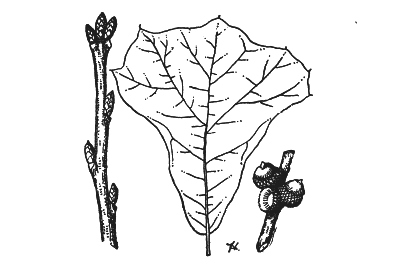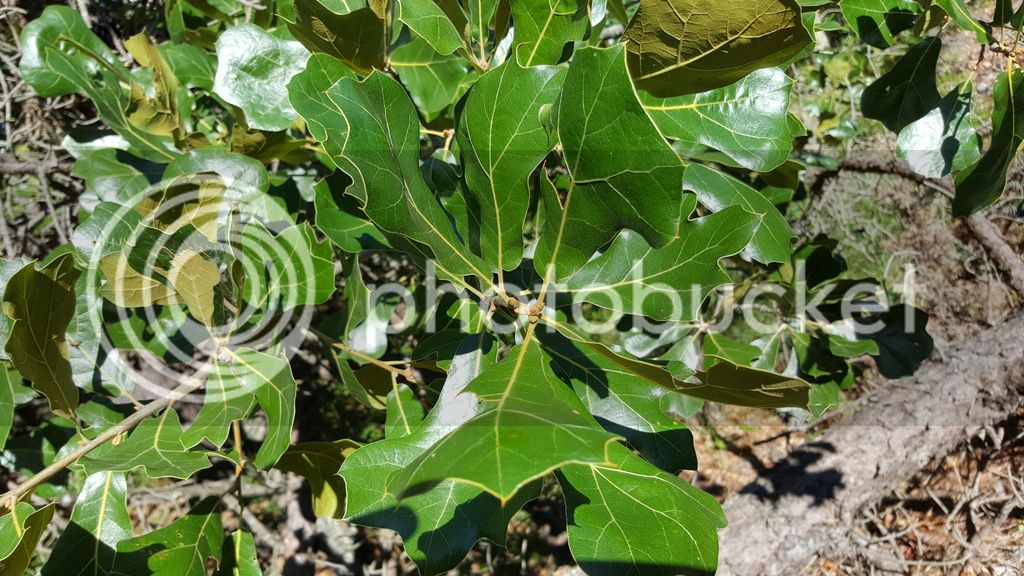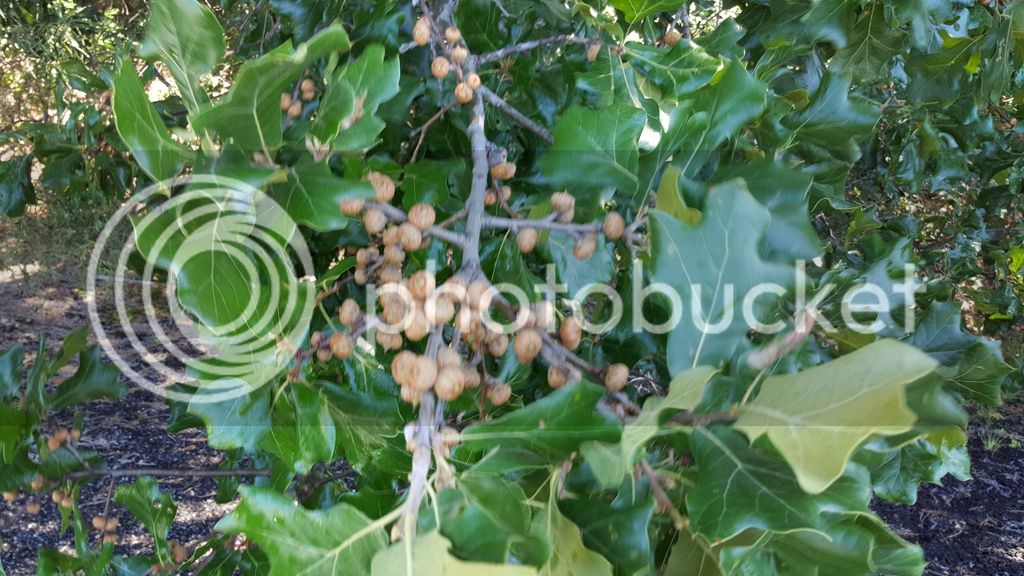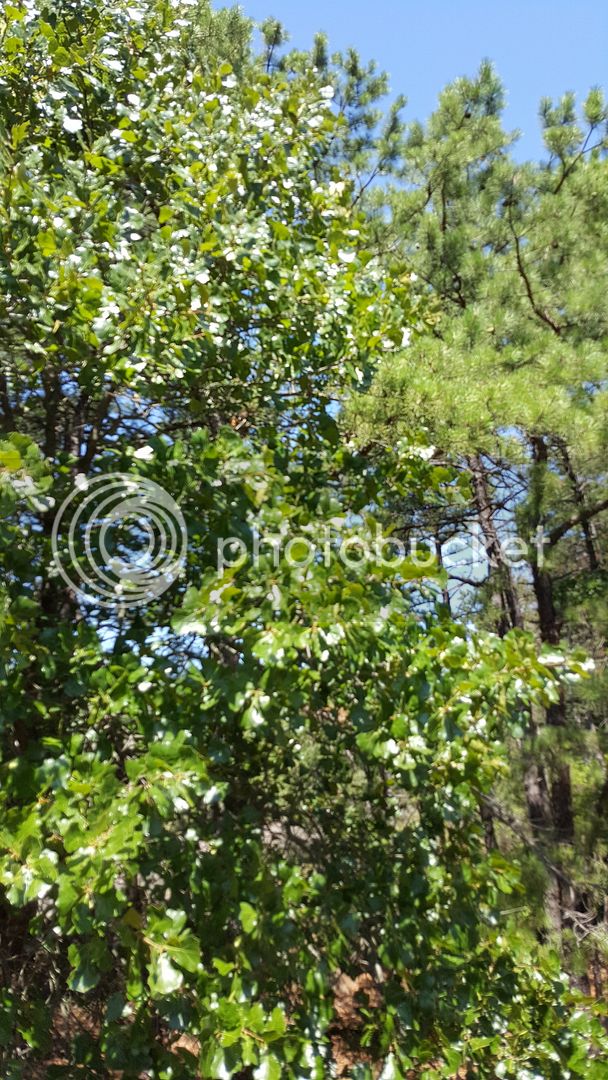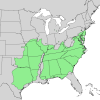Bur Oak (Quercus macrocarpa)
A northern form of bur oak, Quercus macrocarpa var. olivaeformis, has
been recognized (5). Acorns of this
form often germinate in the spring following seedfall rather than soon
after falling, and germination is improved
by stratification. Acorn size is about half that of the southern form,
and the cup is much thinner and smaller.
Cleaned seeds average 595/kg (270/lb) compared to only 165/kg (75/lb)
for the typical species (16). Where
the two forms are found in the same locality, as in eastern Nebraska,
the typical bur oak is more common on
the moister sites (5,13). Varietal crosses occur in such areas.
Photoperiodic ecotypes of bur oak have also
been recognized. In one study, shoot growth of a more northerly seed
source was about two-thirds of that of
a more southerly seed source under short days; under long days, shoot
growth of both sources was nearly
equal (24).
Hybrids
Bur oak has been known to hybridize with nine species as follows: white
oak, Q. x bebbiana Schneid.; swamp
white oak, Q. x schuettei Trel.; Gambel oak (Q. gambellii); overcup oak,
Q. x megaleia Laughlin; swamp
chestnut oak, Q. x byarsii Sudw.; chinkapin oak (Q. muehlenbergii), Q. x
deamii Trel.; English oak (Q.
robur); post oak, Q. x guadalupensis Sarg.; and live oak (Q.
uirginiana). The cross with white oak, Q. x
bebbiana, Bebb oak, is one of the most frequent of the white oak hybrids
and is widespread within the
overlapping ranges of the two species (9). The hybrid formed with Gambel
oak, a western species, is
somewhat unusual in that the two species do not now have overlapping
ranges (15).
-------------------------------------------
Swamp Chestnut Oak (Q. michauxii)
Swamp chestnut oak hybridizes with Quercus alba (Q. x beadlei Trel. ex
Palmer); Q. lyrata (Q. x tottenii
Melvin); and Q. macrocarpa (Q. x byarsii Sudw.)
----------------------------------------------
Quercus montana Willdenow,
Mountain chestnut oak, rock chestnut oak
The four species of the chestnut oak group in eastern North America (
Quercus montana , Q . michauxii , Q . muhlenbergii , and Q . prinoides )
are somewhat difficult to distinguish unless careful attention is paid
to features of leaf vestiture and fruit and cup morphology.
[
http://www.efloras.org/florataxon.aspx?flora_id=1&taxon_id=233501064]
------------------------------
Chinkapin Oak (Q. muehlenbergii)
Chinkapin oak intergrades with dwarf chinkapin oak (Quercus prinoides)
and both have been recognized as
varieties of the same species by some authors. Dwarf chinkapin oak,
however, is commonly a low-growing,
clump-forming shrub, rarely treelike, and is a separate distinct
species.
Two recognized, named hybrids of chinkapin oak are Q. x introgressa P M.
Thomson (Q. muehlenbergii x Q.
bicolor x prinoides), and Q. x deamii Trel. (Q. muehlenbergii x
macrocarpa).
Chinkapin oak is also known to hybridize with white oak (Q. alba);
Gambel oak Q. gambelii); and dwarf
chinkapin oak (Q. prinoides) (6).
----------------------------------------------
Water Oak (Q. nigra)
There are no reported racial variations of water oak. It hybridizes with
other oak species as follows (3):
Quercus falcata (Q. x garlandensis Palmer), Q. incana (Q. x caduca
Trel.), Q. laevis (Q. x walteriana Ashe),
Q. marilandica (Q. x sterilis Trel.), Q. phellos Q x capesii W Wolf), Q.
shumardii (Q. x neopalmeri Sudw.),
and Q. velutina (Q. x demarei Ashe).
-----------------------------------------------
Nuttall Oak (Q. nuttallii)
No racial variations or hybrids have been reported. North of Memphis,
TN, this tree is easily confused with
Q. palustris (pin oak).
---------------------------------------------
Pin Oak (Q. palustris)
No races or genetically distinct populations have been defined within
pin oak, but the existence of such
populations has been suggested based on differences in flood tolerance
and resistance to iron chlorosis (3,9).
Five hybrids of pin oak are recognized (17): Quercus x mutabilis Palmer
& Steyerm. (Q. palustris x
shumardii), Q. x vaga Palmer & Steyerm. (Q. palustris x velutina), Q. x
schochiana Dieck (Q. palustris x
phellos), Q. x columnaris Laughlin (Q. palustris x rubra), and an
unnamed hybrid with Q. coccinea.
----------------------------------------------
Willow Oak (Q. phellos)
No racial variations of willow oak are known, but the following hybrids
are recognized (14): Quercus phellos
x nigra (Q. x capesii W. Wolf); Q. phellos X velutina (Q. x filialis
Little); Q. phellos x ilicifolia (Q. x giffordii
Trel.); Q. phellos x rubra (Q. heterophylla Michx. Q; Q. phellos x
falcata (Q. x ludoviciana Sarg.); Q. phellos
x shumardii (Q. x moultonensis Ashe); Q. phellos x marilandica (Q.
rudkinii Britton); Q. phellos x palustris (Q.
x schociana Dieck.).
---------------------------------------------
Chestnut Oak (Q. prinus)
No races of chestnut oak are known. Chestnut oak hybridizes with Quercus
alba (Q. x saulii Schneid.); Q.
bicolor; Q. robur (Q. x sargentii Rehd.); and Q. stellata (Q. x
bernardiensis W. Wolf) (19).
----------------------------------------------------
Northern Red Oak (Q. rubra)
Several traits related to geographic origin were identified for northern
red oak in a 14-year provenance test in
the North- Central States. Time of flushing is earliest for trees of
northwestern origin. The trend is then
eastward and southward. Autumn leaf coloration is earliest for
provenances from northern latitudes and then
progresses southward. Provenances from regions at the western edge of
the northern red oak range, where
periods of high summer temperatures and drought are common, survived
better under such conditions than
other provenances. Much variation in height growth was present and
performance of the provenances was not
consistent in all tests. The only consistent difference was the slower
growth of the northern provenances in
areas farther south. The within-family variation was so great it
obscured any real differences in geographic
origin (15).
Races
The nomenclature for northern red oak was confused for some time. The
scientific names Quercus borealis
Michx. f. and Q. borealis var. maxima (Marsh.) Sarg. were adopted after
1915 by some authors, but in 1950,
Quercus rubra L., the name in universal use before 1915, was restored
(17).
Hybrids
Northern red oak hybridizes readily with other species in the subgenus
Erythrobalanus and the following
hybrids have been named: Quercus x columnaris Laughlin (Q. palustris x
rubra); Q. x fernaldii Trel. (Q.
ilicifolia x rubra); Q. x heterophylla Michx. f. (Q. phellos x rubra);
Q. x hawkinsiae Sudw. (Q. velutina x
rubra); Q. x riparia Laughlin (Q. shumardii x rubra); and Q. x runcinata
(A. DC.) Engelm. (Q. imbricaria x
rubra).
------------------------------------------------------
Shumard Oak (Quercus shumardii)
Shumard oak has two varieties-Quercus shumardii Buckl. var. shumardii
(typical), and Q. shumardii var.
texana (Buckl.) Ashe, Texas oak, found in central Texas, including the
Edwards Plateau, and in southern
Oklahoma in the Arbuckle Mountains.
Shumard oak hybridizes with Quercus hypoleucoides; Q. imbricaria Q. x
egglestonii Trel.); Q. marilandica (Q.
x hastingsii Sarg.); Q. nigra (Q. x neopalmeri Sudw.); Q. nuttallii; Q.
palustris (Q. x mutabilis Palmer &
Steyerm.); Q. phellos (Q. x moultonensis Ashe), Q. rubra (Q. x riparia
Laughlin); and Q. velutina Q. x
discreta Laughlin) (4).
------------------------------------------------------
Post Oak (Quercus stellata)
The great variation in post oak and its tendency to hybridize creates a
number of varieties and hybrids. The
following hybrids with Quercus stellata have been recognized (10): Q.
alba (Q. x fernowii Ti-el.); Q. bicolor
(Q. x substellata Trel.); Q. durandii (Q. x macnabiana Sudw.); Q.
havardii (unnamed); Q. lyrata (Q. x sterrettii
Trel.); Q. macrocarpa (Q. x guadalupensis Sarg.); Q. minima (Q. x
neo-tharpii A. Camus); Q. mohriana
(unnamed); Q. prinoides (Q. x stelloides Palmer); Q. prinus (Q. x
bernardiensis W. Wolf); Q. virginiana (Q. x
harbisonii Sarg.).
-------------------------------------------------------
